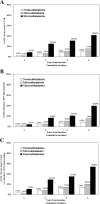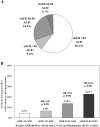Association of kidney disease measures with risk of renal function worsening in patients with type 1 diabetes
- PMID: 30514308
- PMCID: PMC6280443
- DOI: 10.1186/s12882-018-1136-6
Association of kidney disease measures with risk of renal function worsening in patients with type 1 diabetes
Abstract
Background: Albuminuria has been classically considered a marker of kidney damage progression in diabetic patients and it is routinely assessed to monitor kidney function. However, the role of a mild GFR reduction on the development of stage ≥3 CKD has been less explored in type 1 diabetes mellitus (T1DM) patients. Aim of the present study was to evaluate the prognostic role of kidney disease measures, namely albuminuria and reduced GFR, on the development of stage ≥3 CKD in a large cohort of patients affected by T1DM.
Methods: A total of 4284 patients affected by T1DM followed-up at 76 diabetes centers participating to the Italian Association of Clinical Diabetologists (Associazione Medici Diabetologi, AMD) initiative constitutes the study population. Urinary albumin excretion (ACR) and estimated GFR (eGFR) were retrieved and analyzed. The incidence of stage ≥3 CKD (eGFR < 60 mL/min/1.73 m2) or eGFR reduction > 30% from baseline was evaluated.
Results: The mean estimated GFR was 98 ± 17 mL/min/1.73m2 and the proportion of patients with albuminuria was 15.3% (n = 654) at baseline. About 8% (n = 337) of patients developed one of the two renal endpoints during the 4-year follow-up period. Age, albuminuria (micro or macro) and baseline eGFR < 90 ml/min/m2 were independent risk factors for stage ≥3 CKD and renal function worsening. When compared to patients with eGFR > 90 ml/min/1.73m2 and normoalbuminuria, those with albuminuria at baseline had a 1.69 greater risk of reaching stage 3 CKD, while patients with mild eGFR reduction (i.e. eGFR between 90 and 60 mL/min/1.73 m2) show a 3.81 greater risk that rose to 8.24 for those patients with albuminuria and mild eGFR reduction at baseline.
Conclusions: Albuminuria and eGFR reduction represent independent risk factors for incident stage ≥3 CKD in T1DM patients. The simultaneous occurrence of reduced eGFR and albuminuria have a synergistic effect on renal function worsening.
Keywords: Albuminuria; Diabetic kidney disease; GFR.
Conflict of interest statement
Ethics approval and consent to participate
Ethics approval and informed consent to participate was not required given that the automated anonymized database precludes identification of individual patients (
Consent for publication
Not applicable.
Competing interests
The authors declare that they have no competing interests.
Publisher’s Note
Springer Nature remains neutral with regard to jurisdictional claims in published maps and institutional affiliations.
Figures





References
Publication types
MeSH terms
LinkOut - more resources
Full Text Sources
Research Materials
Miscellaneous

